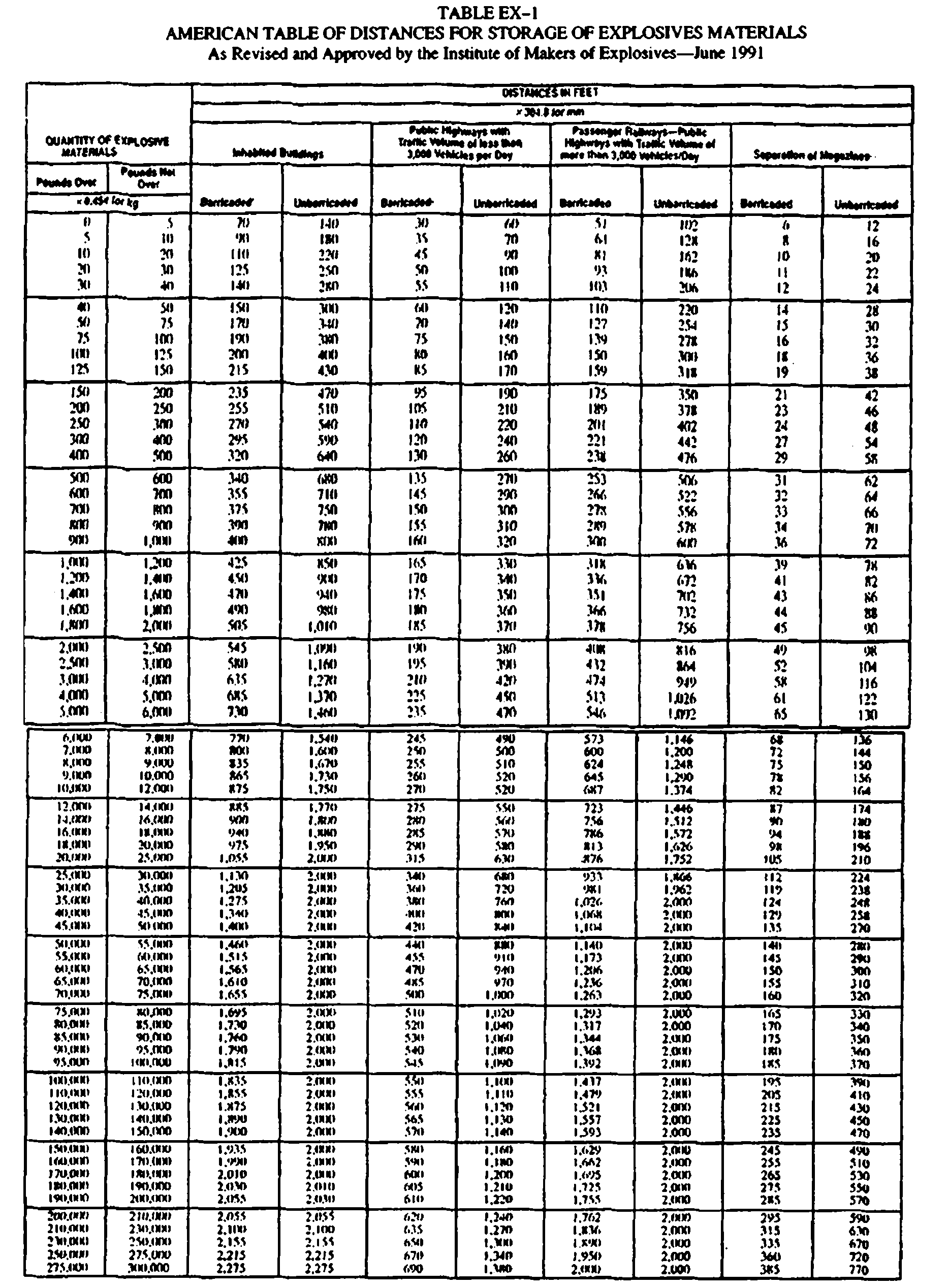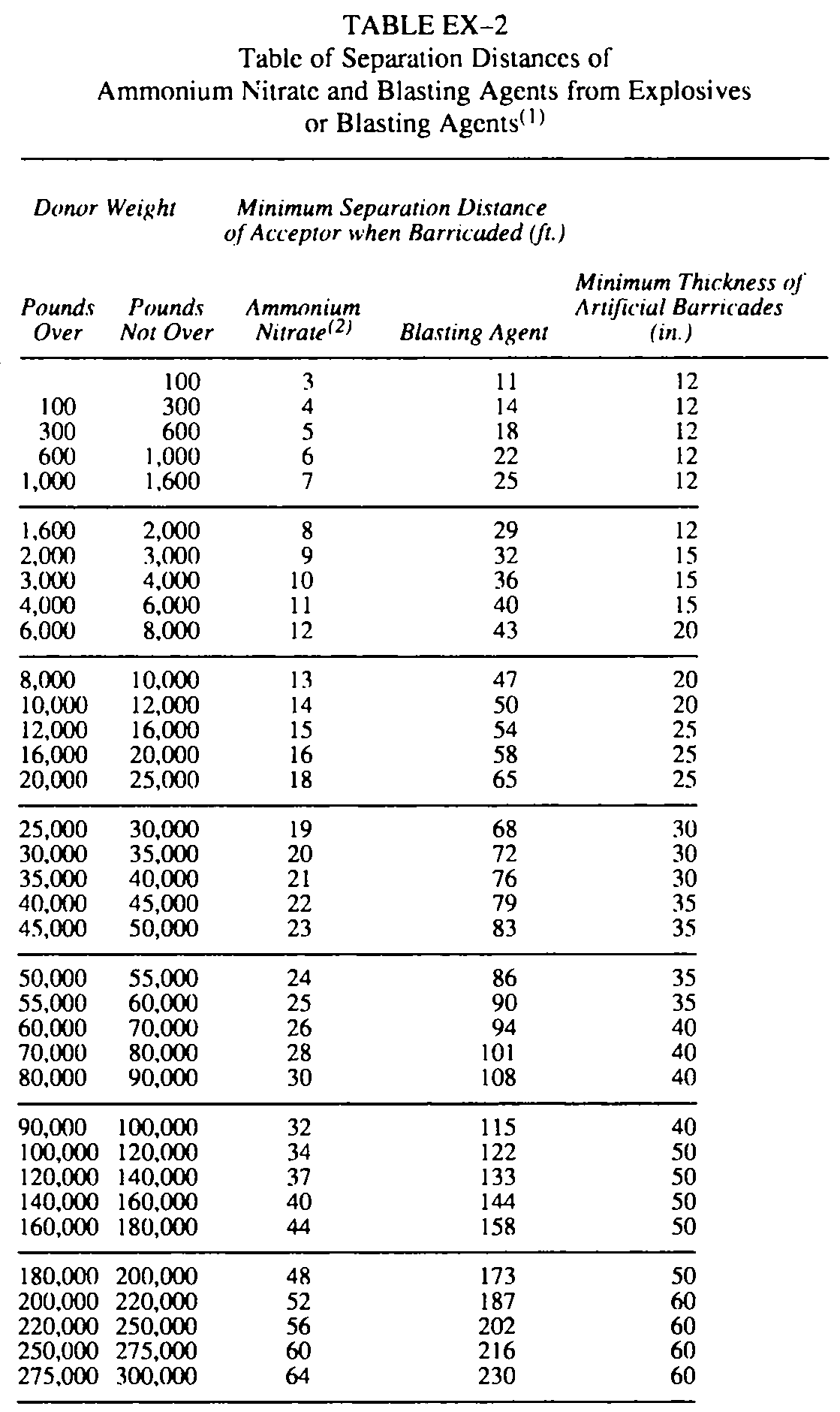 |
California Code of Regulations (Last Updated: August 6, 2014) |
 |
Title 8. Industrial Relations |
 |
Division 1. Department of Industrial Relations |
 |
Chapter 4. Division of Industrial Safety |
 |
Subchapter 7. General Industry Safety Orders |
 |
Group 18. Explosive Materials |
 |
Article 114. Storage of Explosive Materials |
§ 5252. Quantity and Distances Table for the Storage of Explosive Materials.
Latest version.
- (a) The quantity of explosive materials that may be kept or stored in any magazine shall conform to Table EX-1, Table of Distances, which sets forth the minimum distance that a magazine may be located from the nearest inhabited building or other magazine.(b) The quantity and distance table is not applicable to any magazine if the nearest inhabited building is effectually screened from the magazine by a natural barrier, which:(1) Is 40 feet or more in height at any point, above a straight line drawn from the top of any sidewall of the magazine to any part of the inhabited building; and(2) Has a natural thickness of not less than 200 feet at the point where it is intersected by the straight line.(c) All types of blasting caps in strength through No. 8 shall be rated at 1 1/2 pounds of explosives per 1,000 caps. For strengths higher than No. 8 cap, consult the manufacturer.(d) For quantity and distance purposes detonating cord up to 60 grains per foot shall be calculated as equivalent to 9 pounds of high explosives per 1,000 feet. Heavier detonating cord shall be rated proportion- ately.(e) When two or more storage magazines are located on the same property, each magazine must comply with the minimum distances specified from inhabited buildings, railways, and highways; and, in addition, they shall be separated from each other by not less than the distances shown for “Separation of Magazines,” except that the quantity of explosive materials contained in cap magazines shall govern in regard to the spacing of said cap magazines from magazines containing other explosive materials. If any two or more magazines are separated from each other by less than the specified “Separation of Magazines” distances, then such two or more magazines, as a group, must be considered as one magazine, and the total quantity of explosive materials stored in such group must be treated as if stored in a single magazine located on the side of any magazine of the group, and must comply with the minimum of distances specified from other magazines and inhabited buildings.TABLE EX-1 AMERICAN TABLE OF DISTANCES FOR STORAGE OF EXPLOSIVES MATERIALS As Revised and Approved by the Institute of Makers of Explosives -June 1991TABLE EX-2 Table of Separation Distances of Ammonium Nitrate and Blasting Agents from Explosives or Blasting Agents (1)Donor WeightMinimum Separation Distanceof Acceptor when Barricaded (ft.)Minimum Thickness ofPoundsPoundsAmmoniumArtificial BarricadesOverNot OverNitrateBlasting Agent(in.)1003111210030041412300600518126001,000622121,0001,600725121,6002,000829122,0003,000932153,0004,0001036154,0006,0001140156,0008,0001243208,00010,00013472010,00012,00014502012,00016,00015542516,00020,00016582520,00025,00018652525,00030,00019683030,00035,00020723035,00040,00021763040,00045,00022793545,00050,00023833550,00055,00024863555,00060,00025903560,00070,00026944070,00080,000281014080,00090,000301084090,000100,0003211540100,000120,0003412250120,000140,0003713350140,000160,0004014450160,000180,0004415850180,000200,0004817350200,000220,0005218760220,000250,0005620260250,000#i275,0006021660275,000300,0006423060NOTES:(1) Separation distances to prevent explosion of ammonium nitrate and ammonium nitrate-based blasting agents by propagation from nearby stores of high explosives or blasting agents referred to in the Table as the “donor”. Ammonium nitrate, by itself, is not considered to be a donor when applying this Table. Ammonium nitrate, ammonium nitrate-fuel oil or combinations thereof are acceptors. If stores of ammonium nitrate are located within the sympathetic detonation distances of explosives or blasting agents, one-half the mass of the ammonium nitrate should be included in the mass of the donor.(2) The distances in the Table apply to ammonium nitrate that passes the insensitivity test prescribed in the definition of ammonium nitrate fertilizer promulgated by The Fertilizer Institute, and ammonium nitrate failing to pass said test shall be stored at separation distances determined by competent persons.TABLE EX-3 Types of Storage FacilitiesAs a result of tests with electric blasting caps, it has been determined that these blasting caps are not subject to sympathetic detonation. Therefore, a Type 4 storage facility meets the necessary requirements for storage of blasting caps that do not mass detonate.HISTORY1. Repealer and new section filed 10-17-75; effective thirtieth day thereafter (Register 75, No. 42).2. Amendments filed 7-16-76; effective thirtieth day thereafter (Register 76, No. 29).3. Amendment filed 9-18-80; effective thirtieth day thereafter (Register 80, No. 38).4. Amendment of section heading, section and Note, including transfer of section 1938, App B, Plate B-14, table 1to replace former Table EX-1; transfer of section 5253 Table EX-2 to new section 5252 Table EX-2; and transfer of section 1938, App B, Plate B-14ato new Table EX-3, filed 7-11-2003; operative 8-10-2003 (Register 2003, No. 28).
Note
Note: Authority cited: Section 142.3, Labor Code. Reference: Section 142.3, Labor Code; and Section 12006, Health and Safety Code.


